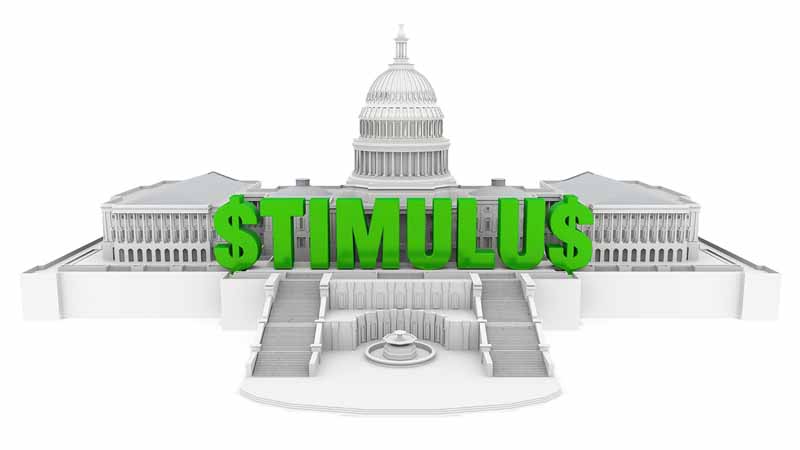What We Know About the Second Stimulus Package: What It Will Include, Why It’s Taking So Long
In March, the U.S. government signed into law the Coronavirus Aid, Relief, and Economic Security (CARES) Act, a $3 trillion federal stimulus package that provided economic support for an economy nose-diving amid an unprecedented global health crisis. As the pandemic dragged on, however, aid quickly began to dry up, so today, nearly seven months into the COVID-19 crisis, many businesses on the brink are pleading the federal government for a lifeline.
Here’s what we know about the second stimulus package, currently in the works in Washington D.C.:

Everyone Agrees It’s Necessary
The one thing that’s not up for debate about the next round of stimulus aid is its necessity. Pretty much everyone agrees that the US economy, officially in recession, is in dire need of a boost. Nearly 30 million people received unemployment benefits near the end of August while almost 25% of small businesses in weekly census surveys said they will need additional financial assistance or capital in the coming months. 70% of Americans want a second stimulus check while Democrats and Republicans alike agree something needs to happen as soon as possible. “It’s very important that we have stimulus that helps the areas of the economy that need support,” said Treasury Secretary Steven Mnuchin on September 14.
So, where is it?
The Hold-Up Is in Washington
Unfortunately, while politicians agree that the stimulus package is necessary, they can’t agree on its cost. A larger stimulus package could fund more stimulus programs, including a second stimulus check. A smaller package could drop funding and relieve the ballooning national debt, but decreases the initiative’s scope. As a result, the aid has been gridlocked in Washington D.C. for weeks amid contentious back-and-forth debates between both parties—with no clear end in sight.
Republicans want a less expensive stimulus package. The Senate GOP has held strong that it will not pass any new package exceeding $1 trillion, the size of the original HEALS Act proposal released in July.
Democrats want a more expensive stimulus package. The original proposal from Democrats was for a $3.4 trillion stimulus package, which Republicans disagreed with. House Speaker Nancy Pelosi (D-Calif.) has since offered to meet halfway at $2.2 trillion.
Neither side has signaled willingness to budge on their latest proposals, leaving an at least $1 trillion gap, which doesn’t make the possibility of passing legislation any time soon hopeful. President Trump has weighed in, urging Republicans to spend more money on the next stimulus bill. “Go for the much higher numbers, Republicans, it all comes back to the USA anyway,” Trump tweeted on September 16.
What Will Be in It?
Both the original proposals from Republicans and Democrats include money for a second stimulus check of up to $1,200. They differ on the money set aside for other measures to include for economic relief.
The HEALS (Health, Economic Assistance, Liability, Protection and Schools) Act, introduced by Senate Republicans in July, includes:
- A second $1,200 stimulus check ($2,400 for married filing jointly) that looks identical to CARES direct payments earlier this year, except taxpayers with dependents of any age will qualify for the additional $500 per dependent rebate
- Enhanced unemployment benefits, but in a smaller amount ($200), followed by a system aimed at replacing 70% of a recipient’s prior income by leaning upon state assistance
- The extension of the Paycheck Protection Program (PPP)
- Liability protection for individuals, businesses, and healthcare providers to protect against coronavirus lawsuits
The Democrats’ Heroes Act, passed by House Democrats in May, includes:
- A second $1,200 stimulus check ($2,400 for married filing jointly), which provides an additional $1,200 for each dependent child
- Enhanced unemployment benefits at $600 per week
- Additional funding for the Supplemental Nutrition Assistance Program
- Additional funding for small businesses
- Emergency relief for the US Postal Service
- Funding for state and local governments
- Hazard pay for essential workers
- Rent and mortgage assistance
Last week, Senate Republicans attempted to pass a pared-down emergency package that would’ve offered $350 billion in new funding and repurposed billions from the original stimulus law. This “skinny” package would’ve included federal aid for unemployed workers, small businesses, vaccine development, and schools, in addition to a renaissance of weekly federal jobless benefits. The package was missing aid for states and cities, as well as stimulus checks. Thus, it did not gain the 60 votes needed to defeat a filibuster and was struck down.
Another option has been put on the table by a group of 50 Republicans and Democrats in the House, dubbed the Problem Solvers Caucus. This bill, titled “March to Common Ground,” totals $2 trillion and includes $290 billion for small businesses, $500 billion in state and local aid, $120 billion in enhanced unemployment benefits, $316 billion in direct payments to individuals and families, and $100 billion for testing and healthcare. Unfortunately, this bill has received sharp criticism from both sides of the aisle and appears to be a long-shot.
What Happens Next?
Few on Capitol Hill think Congress will be able to agree upon and pass a stimulus package before election day. The Senate and the House breaks are scheduled for October 9.
However, that doesn’t mean all hope is lost. A bill can still be passed after these dates, and House Speaker Pelosi (D-CA) has insisted: “We have to stay here until we have a bill.” Senate Majority Leader Mitch McConnell (R-KY) is also able to compel the Senate to stay in session longer or come back early to vote on the proposal.
Everything will become clear over the next few weeks. Unfortunately, that’s all that can be said as of now.
A silver lining is that when a deal is finally made, Treasury Secretary Steven Mnuchin said it will take just a week to send the first payments. “I could get out 50 million payments really quickly,” he has previously said. The previous CARES funding took around two and a half weeks to mobilize.
In the Meantime
Some people are still waiting for the original stimulus checks. If you’re one of the people who was shut out of the $1,200 check, or didn’t receive the $500 for an eligible dependent, there are two upcoming IRS deadlines which can be used to file information in order to get the money:
- A September 30 deadline for dependent payments
- An October 15 deadline for non-filers
Learn more about this on the IRS website.
Additionally, President Trump last month signed an executive order authorizing extended jobless aid. FEMA has said it will provide the $300 sum for a full six weeks, which should provide some relief to tide people over until a stimulus package is signed into law.
About the Author

Jemima is a journalist who enjoys reporting on business, particularly small business and entrepreneurship.
Startup Resources
- Learn more about Startups
- Visit the TRUiC Business Name Generator
- Check out the TRUiC Logo Maker
- Read our Business Formation Services Review
- Find Startup Ideas
- Explore Business Resources
Form Your Startup
Ready to formally establish your startup? Click below to read our review of the best business formation services!
Best Business Formation Services